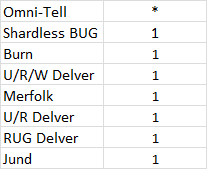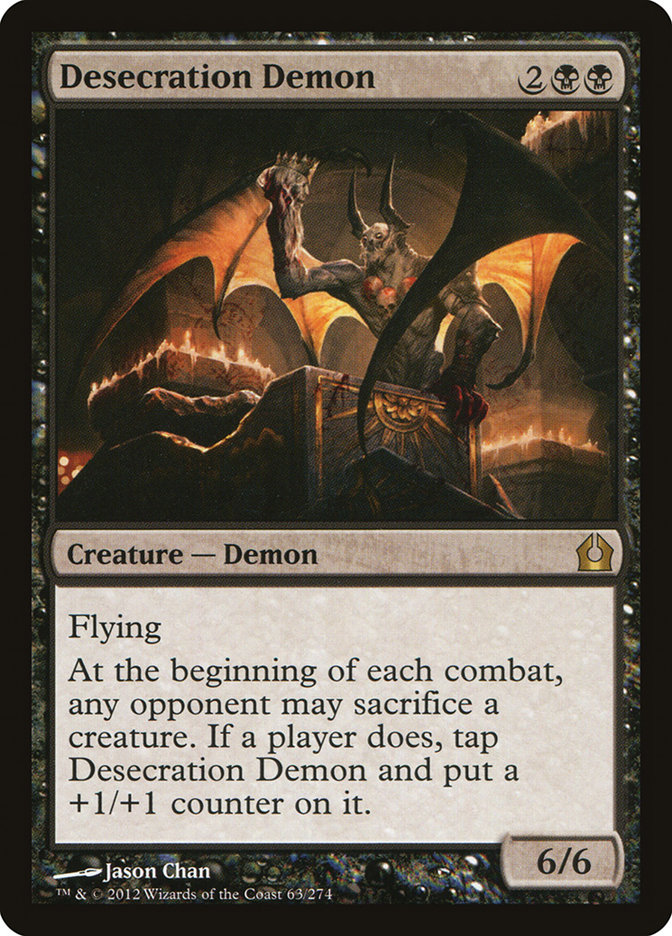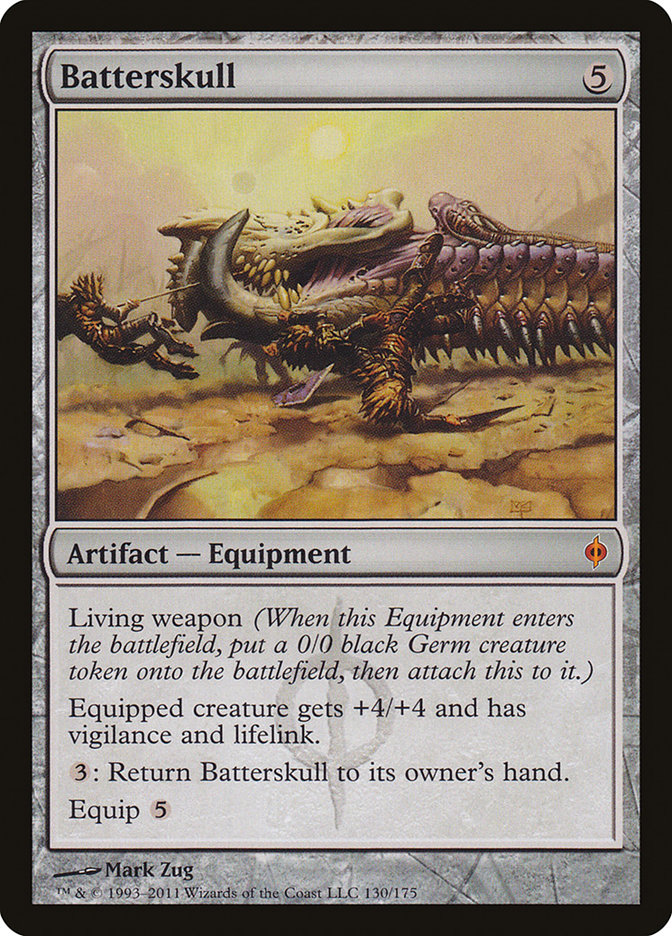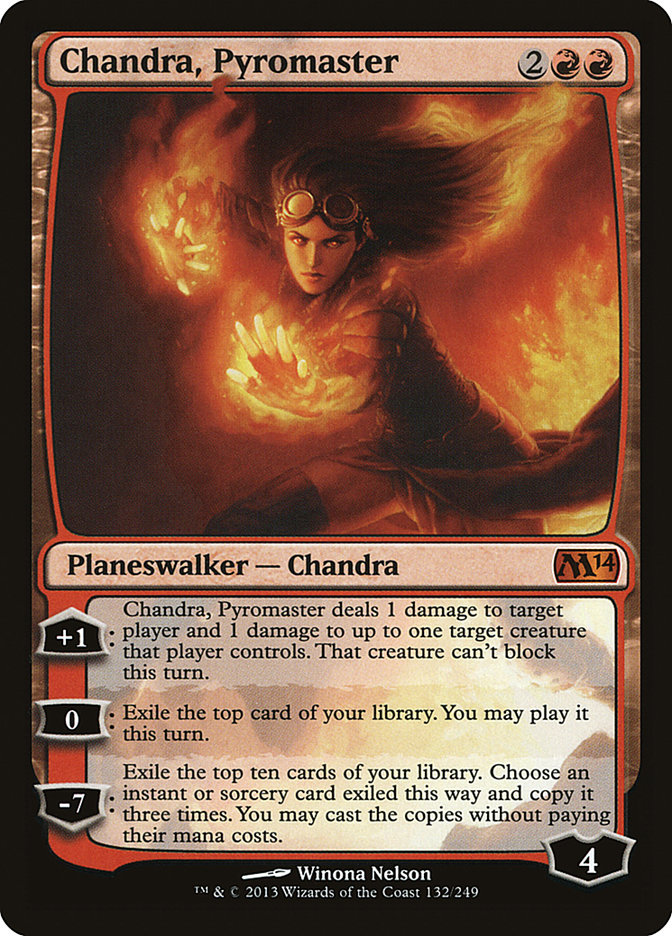New Toys, New Tricks . . . Melira Pod Mesmerizing Modern
Leading off this week’s rundowns is the Modern Top 8 from Grand Prix Detroit, where Melira Pod outlasted a field of many Overgrown Tombs.

Melira Pod
Creatures (28)
- 4 Birds of Paradise
- 1 Spike Feeder
- 1 Eternal Witness
- 1 Wall of Roots
- 1 Orzhov Pontiff
- 1 Reveillark
- 4 Kitchen Finks
- 2 Murderous Redcap
- 1 Ranger of Eos
- 1 Qasali Pridemage
- 2 Viscera Seer
- 1 Spellskite
- 1 Phyrexian Metamorph
- 1 Melira, Sylvok Outcast
- 3 Deathrite Shaman
- 2 Voice of Resurgence
- 1 Archangel of Thune
Lands (23)
Spells (9)

Seeing a Birthing Pod variant succeed in a Modern tournament is nothing particularly new; we have seen decks in the past that lace together any and all manners of Deceiver Exarchs, Restoration Angels, and Kiki-Jiki, Mirror-Breakers to deal infinite damage. The Melira Pod variant instead uses Chord of Calling and Birthing Pod to put together Melira, Sylvok Outcast with persist creatures to break the usual single rebuy restriction.
The one-two-three of Viscera Seer + Melira, Sylvok Outcast + Kitchen Finks actually lets you cycle through your whole deck if you like while gaining all the life you could ever want. On four, Murderous Redcap provides a source of essentially limitless damage (instead of life gain) . . . that is, if everything goes according to plan.
The problem, though, is that the Melira combos assume that not only do your relatively small creatures all avoid getting removed from play but that you have a relatively unfettered path through your graveyard. The way these combos work is by sacrificing a persist creature, thanking Melira for keeping -1/-1 counters off of it, and therefore leaving the same body for another sacrifice over and over again. The Detroit Top 8 alone featured 27 maindeck Deathrite Shamans; one tap from a Shaman can break up the Melira combo (and don’t forget that there were also a ton of Scavenging Oozes and other graveyard hosers played).
The new combo of Spike Feeder + Archangel of Thune gives Melira Pod another powerful combo—one that does not rely on the graveyard. You can put these two life gain creatures together and go ahead and gain infinite life. Remove a +1/+1 counter from Spike Feeder, gain some life, trigger Archangel of Thune, put a +1/+1 counter on everyone (including of course the Spike Feeder); because Spike Feeder treats all +1/+1 counters the same, you can rinse and repeat.
The Melira Pod deck has some surprising resistance to aggro; both Spike Feeder and Kitchen Finks are fast enough to pair up against offensive creatures, dramatically assisting Melira Pod in taking on all kinds of opponents. Here is a strategy that is two or three infinite combo decks that can act like a regular old midrange one as well.
Now, speaking of midrange, even a cursory glance at the GP Detroit Top 8 should clue you in on the popularity and power of the B/G decks. The B/G and B/G/R decks all leaned on a combination of Thoughtseize and green guys to disrupt combo and prove up card quality themselves. In addition, many of these decks added a little something extra to differentiate themselves or gain an advantage.
B/G Midrange
Creatures (16)
Planeswalkers (3)
Lands (25)
Spells (14)

Willy Edel played a very straightforward B/G Midrange deck.
In addition to usual suspects Dark Confidant and Tarmogoyf, Edel bolstered his B/G with big guys like Standard B/G staple Desecration Demon and multi-format catchall Batterskull. These threats are potentially hard to handle given the shape of the Modern metagame, specifically its predicted answer cards.
Desecration Demon is just big and big for its cost. Look at Willy’s own deck; how would he kill one? Maelstrom Pulse can take down Desecration Demon, but Abrupt Decay and Dismember can’t; the edict on Liliana of the Veil is a bit of a gamble. It’s just . . . big. Batterskull is super resilient and given sufficient mana inevitable in a fair fight. Again, there are some answers, but not an overwhelming number. Both Desecration Demon and Batterskull can create mismatches that have to be answered in relatively short order.
One of the advantages of B/G versus Modern Deck To Beat Jund is the ability to play lots of anti-land lands; Willy ran not only Tectonic Edge to that end but a solo Encroaching Wastes! Further, he played four copies of Fulminator Mage in his sideboard. The mana denial plan can be looked at and applied in a number of different ways. You can keep an opponent off a number or a color; you can protect a planeswalker by taking out a Celestial Colonnade; and, of course, you can keep your opponent off of their Urzatron (which will very likely go over the top of your midrange deck in circa one turn if left untouched).
Fellow B/G player Marcelino Freeman played Fulminator Mage maindeck.
Ajundi
Creatures (14)
Planeswalkers (6)
Lands (24)
Spells (16)

Essentially the opposite of B/G, where a Jund player cuts one of their three colors, you can try to gain an edge with Ajundi (Jund with Ajani Vengeant), which takes Jund and adds the color white.
In a sense the inclusion of Ajani Vengeant can be seen as a reaction to the banning of Bloodbraid Elf. Now, obviously banning Bloodbraid Elf did not have the desired effect of displacing Jund as the Deck To Beat . . . but hey, at least all these Jund decks don’t have four copies of their best card each any longer.
Ajani Vengeant was a contemporary of Bloodbraid Elf in Standard, the same total mana cost and reasonably comparable in card power. Aiding and abetting at the Bloodbraid-absent four is Standard Jund staple Olivia Voldaren. Both Ajani Vengeant and Olivia Voldaren do things kind of like Bloodbraid Elf. They can both remove opposing threats with value. They are both disruptive in a sense and (depending on the opponent’s strategy) can tax their mana or take the edge off their efficiency. While Bloodbraid Elf kind of got in, did something cool, and then often died immediately, Olivia and Ajani are the kind of fours that can take a game over all by themselves . . . but not quickly at all.
Playing white for Ajani Vengeant gave Moir an easy open to play Lingering Souls, the cross-format All-Star that probably doesn’t need a lot of introduction. In Modern, Lingering Souls can hold off powerful threats, force the usually fearless Signal Pest to think twice before attacking, or provide some desperate annihilator fodder. Perhaps most importantly given the popularity of Liliana of the Veil, Lingering Souls is great against both of her common abilities. Edicts are terrible against card advantage token producers, and forcing the opponent to discard gets a lot less exciting when you are forcing them to discard a card with flashback.
But maybe the most interesting card in Moir’s deck is this solo in his sideboard:
Jund
Chandra was played as a two-of maindeck in dreamboat Reid Duke Jund variation, a defining difference maker and his deck’s way of getting an edge in a sea of similar strategies.
Creatures (14)
Planeswalkers (6)
Lands (24)
Spells (16)

Reid was generous enough to share a lot of what makes Chandra special in his Jund, which I will now share with you:
1. Chandra ensures you will win even games. If games stall out, you have an advantage due to card advantage. So many of the cards in these decks are geared towards trading and/or attrition. Chandra can shoot down a Dark Confidant, draw you into removal for a permanent, or produce a permanent off the top itself. All of those things are good when two guys are basically throwing cards at each other’s cards.
2. Chandra can force your threats through while leveling up. Tarmogoyf’s only shortcoming is a lack of evasion. It might be big, but the opponent can chump it. Well, not if Chandra is going [+1].
3. Chandra is particularly good at taking out the small/especially mana creatures in Birthing Pod, as well as providing resistance to Lingering Souls.
4. The Jund deck is already set up to defend planeswalkers. It’s full of removal to shoot down attackers. It has discard to stop answers before they become answers. And big guys like Tarmogoyf make for very effective blockers.
Now, while the B/G and Jund variants are all cleverly trying to find different ways to get the jump on themselves, there’s another way to skin that particular cat . . .
Affinity
Creatures (25)
- 4 Arcbound Ravager
- 4 Ornithopter
- 3 Steel Overseer
- 2 Memnite
- 4 Etched Champion
- 4 Signal Pest
- 4 Vault Skirge
Lands (16)
Spells (19)

A far cry from the Red Robots of earlier Modern Affinity decks, Alex’s leans hard on Glimmervoid, Mox Opal, and Springleaf Drum to play powerful individual cards in each of the many colors.
- Black – In case you were wondering what the best card in Theros is, there were 29of a possible 32 Thoughtseizes in this Top 8, including three in the sideboard of this artifact deck.
- Blue – Interestingly Majlaton played a basic Island but only three copies of Thoughtcast for blue spells. The non-alternate activation on Spellskite maybe? Black in particular actually competed pretty solidly for colored requirements in this deck.
- Green – Die artifacts and enchantments, die!
- Red – Galvanic Blast, though only as a two-of, made for some maindeck red. Ancient Grudge in the sideboard, of course.
- White – Pretty heavy requirements here. Rest in Peace is an important one; remember it not only shuts down graveyard-based strategies but takes the edge off of Snapcaster Mage and Tarmogoyf Both.
Legacy in Atlanta
The SCG Legacy Open in Atlanta gave us yet another eight-archetype set of elimination rounds!

It is probably obvious that Legacy is a big and interesting format. So big that you can take a fairly conservative slice out of it and come away with plenty of interesting, powerful, and viable decks just in that subset. You can look at them and for a moment—or perhaps for a lifetime—convince yourself that that slice is everything in Legacy.
There are lots of folks, for example, who think of Legacy as a format of/featuring degenerate combo decks. And there are those that think of Legacy as the format where they can [still] play Jace, the Mind Sculptor. Others think of Legacy as a format where you can play fair strategies very effectively because the sheer volume of good fair cards all added together almost yield an unfair deck.
But the reality is that Legacy’s enormity makes it a place where G/W Maverick decks are at least periodically quite good (even though it doesn’t seem like they ever should be) and a format that lets you play a handful of different Delver of Secrets and/or Goblin Guide decks. Those are the decks I want to talk about in this segment this week.
RUG Delver
Creatures (12)
Lands (18)
Spells (30)

A pillar of the Legacy format, RUG Delver is essentially the baseline Delver of Secrets deck. Taylor Scott played essentially the default RUG Delver, which combines super high quality and dangerous/fast creatures with a Stifle + Wasteland eight pack designed to mana screw many Legacy land bases.
RUG Delver isn’t broken, at least by Legacy standards, but the low mana CMCs and high degree of efficiency of its cards allow it to shift between strategies: offense, CounterSliver, Ponza, removal.
RUG Delver vs. U/R Delver
Creatures (15)
Lands (19)
Spells (26)

U/R Delver is like a less powerful RUG Delver that can actually do more broken things, if that makes any sense. U/R Delver lacks RUG Delver’s more powerful creatures (Tarmogoyf and Nimble Mongoose) but exchanges the speed and quality of those drops—as well as the mana screw wins provided by the Wasteland plan—for an overwhelming degree of reach. U/R Delver will just beat you with Snapcaster Mage and Price of Progress if it gets the right draw.
U/R Delver isn’t "a good deck" in the same way that RUG Delver so consistently is . . . but a good portion of the time it will perform like a combo deck. In addition to Delver of Secrets, U/R Delver can get hyperaggressive draws on the opponent with Goblin Guide.
U/R Delver vs. Burn
The last time I saw him at a recent SCG Invitational, I had a long discussion with Patrick Sullivan about the relative virtues of U/R Delver versus Burn. My advocacy of U/R Delver was rooted in the ability to win not just via Goblin Guide and Price of Progress . . . but to fight combo decks with its light permission suite.
These same cards are why PSulli likes Burn more!
Burn will never be an inch from winning and topdeck a Spell Pierce. It is much more internally consistent than U/R Delver.
You know how RUG Delver plays an extensive amount of Wastelands and Stifles and U/R Delver doesn’t play Wasteland at all? Well, U/R Delver, despite having very low CMCs and theoretically very good mana, can still fall victim to the common mana denial cards in the format. Look at Doug Honeycutt’s Burn deck; no one is ever getting money on a Wasteland here.
Doug’s maindeck plays like an upgraded descendent of many different Standard formats’ red decks all glued together. The one card that stood out to me—that I would actually love to see graduate to a four-of in the future—is Young Pyromancer. Honeycutt’s deck is actually pretty creature heavy for a Legacy Burn deck, but essentially half his deck lines up quite nicely with the new 2/1.
U/R/W Delver vs. RUG Delver
Taking it back to RUG Delver as the default Delver deck, let us conclude with white over green:
Creatures (11)
Lands (19)
Spells (30)

It’s hard not to like this deck.
This is the kind of deck that just screams "good Magic."
In the same way that RUG Delver is a "good deck" full of good cards, U/R/W Delver is an echo of the same sentiments coming from a different third color. If anything, the white cards are more iconic and more rewarding.
You get to play Stoneforge Mystic! What is the better two-drop, Stoneforge Mystic or Tarmogoyf? Pretty interesting discussion to be had there, I think.
You get to play Geist of Saint Traft! Lightning Bolt is joined by Swords to Plowshares. Great removal and great removal, all cheap and all capable of helping you force through one of the most offensively elite creatures in the recent history of the game.
Just good Magic all around.
U/R/W is not a perfect deck by any means. Each of the different Delver decks in fact has different ways to lose games that the others (or, for sake of contrast, Burn) won’t lose. But this deck combines card advantage, offensive potential, and flexibility in a way that neither U/R nor RUG can. Then again, instead of busting either Stifle or Price of Progress, it is quite vulnerable to both.
Putting the Cap on [Innistrad] Standard
Here comes Theros!
So . . . this is going to be about all she wrote for Avacyn’s Pilgrim, Snapcaster Mage, and Thragtusk quite soon.
Off they all go with a bang.
Naya Midrange
Creatures (26)
- 3 Scavenging Ooze
- 4 Avacyn's Pilgrim
- 2 Hellrider
- 4 Thundermaw Hellkite
- 2 Flinthoof Boar
- 3 Loxodon Smiter
- 4 Boros Reckoner
- 4 Voice of Resurgence
Planeswalkers (4)
Lands (24)
Spells (6)

Creatures (27)
- 1 Arbor Elf
- 4 Avacyn's Pilgrim
- 2 Huntmaster of the Fells
- 2 Sigarda, Host of Herons
- 3 Thundermaw Hellkite
- 2 Loxodon Smiter
- 1 Aurelia, the Warleader
- 4 Ghor-Clan Rampager
- 4 Boros Reckoner
- 4 Voice of Resurgence
Planeswalkers (4)
Lands (24)
Spells (5)

For a while the deck database called both Open winner Rudy Briksza Naya deck and Jimmie Smith’s Naya "Aggro," but neither is nearly as aggressive as the most aggressive Naya decks of the past few months. Smith’s deck with its big singleton Legendary Angel comes this close to feeling like a ramp deck. Almost. One of the main changes upcoming is the swapping of dual lands from a set that could come into play untapped and contribute to an all one-drops aggro deck versus a set that basically just makes slower, progressive decks look really good.
Briksza played a split of Bonfire of the Damned and Mizzium Mortars, a divide that not just Naya but Jund players worked through for the last year. Has anyone else dreamt of playing cards like Bonfire of the Damned alongside the upcoming swarm of scry spells?
G/R Aggro
Creatures (31)
- 2 Arbor Elf
- 3 Scavenging Ooze
- 4 Strangleroot Geist
- 4 Hellrider
- 3 Thragtusk
- 3 Thundermaw Hellkite
- 4 Flinthoof Boar
- 4 Ghor-Clan Rampager
- 4 Elvish Mystic
Planeswalkers (3)
Lands (24)
Spells (2)

We’ve talked a lot about decks a la Dragonmaster G/R for several weeks (and with good reason). Joseph Greer actually played the off-strategy (but otherwise universally lauded) Thragtusk in his version, but that might actually reinforce what I am about to say:
I don’t see any way for this deck, which burned so hot and quick, to survive the Theros transition.
Elvish Mystic we will still have. But all those hasty threats—Flinthoof Boar, Strangleroot Geist, Hellrider, and Thundermaw Hellkite—are rotating.
Will there be some kind of a G/R deck? In all likelihood, yes. Just not this one, which has been such a superstar combination of carefully chosen cards.
Also rotating: Kessig Wolf Run. I had the honor of working the Open booth with Joey Pasco the weekend Brian Sondag unleashed Wolf Run Ramp on Standard. What a great Standard run that card has had: World Championship win over the dominant team of the era, second Pro Tour victory for an uber popular Hall of Famer, that extra trample kick in Jackie Lee original Hellrider deck. Token creatures, chump blockers, and players at one life everywhere will rejoice at this card’s rotation.
The Legitimate Thragtusk Decks
Creatures (16)
Planeswalkers (4)
Lands (25)
Spells (15)

The B/G Mutilate deck put together a nice little Standard resume over the summer. In its beginning, it felt like a corner strategy that was basically made to beat up on Bant Hexproof, but somewhere along the line (probably with the printing of Lifebane Zombie), it graduated to a legitimate strategy.
The one thing that took me a while to "get" with B/G was the lack of Farseek. There is (rather "could be") enough green for it. Maybe you play four Golgari Guildgates. It actually has no choice but to reinforce your Mutilates. But given the sustained good performances of the no Farseek deck, I at some point concluded that must be a correct instance of killing one’s darlings.
Creatures (26)
- 2 Vampire Nighthawk
- 2 Arbor Elf
- 3 Avacyn's Pilgrim
- 3 Restoration Angel
- 3 Thragtusk
- 2 Disciple of Bolas
- 4 Loxodon Smiter
- 2 Angel of Serenity
- 2 Obzedat, Ghost Council
- 1 Elvish Mystic
- 2 Shadowborn Demon
Lands (23)
Spells (11)

The reprinting of Scavenging Ooze took a lot of the wind out of the sails of what was once the hands-down boogeyman of the Standard format.
Junk Reanimator was forced to adjust. Which is fine. Great. Laudable.
Here is a deck that just gets its cards out. Drew Kuenzinger’s version has four copies of Loxodon Smiter to play on turn 2. And Vampire Nighthawk! And Thragtusk. And Obzedat, Ghost Council. I love multi-dimensional decks with life gain sub-suites.
Unburial Rites is a good card here; it’s a value two-for-one that links up nicely with all the awesome cards Drew chose to play, but because of Scavenging Ooze, it’s no longer the dead center focus of the strategy.
The deck can still unlock a nice achievement with Restoration Angel. That’s one I’m really going to miss.
Speaking of which . . .
Creatures (10)
Lands (26)
Spells (24)

Creatures (9)
Lands (25)
Spells (26)

Creatures (10)
Lands (26)
Spells (24)

Creatures like Restoration Angel are a rare breed. Really rare. Obviously good, and obviously good in a wide number of different strategies. Very nice in decks like Naya Midrange with Huntmaster of the Fells or Thragtusk, but absolutely archetype making when combined with Augur of Bolas or Snapcaster Mage.
A few months ago a new player asked me why Pack Rat isn’t a staple in Standard; she had done nothing but lose to it (and win with it) in Limited. I showed her Restoration Angel, and she understood immediately where the bar was.
Control decks could keep their lands open (at least after the second turn’s Augur of Bolas) thanks to Restoration Angel. It gave them options and stole time from the other guy. When combined with one of the two-mana Wizards, things really started looking up.
If there is one thing I am going to remember most fondly about the Restoration Angel era, it is all the Invitational Top 8s Gerry Thompson made with it in his deck. If there is one thing I love about Constructed, it is a card, deck, or format that allows for consistent performance by players I admire.
I’m pretty sure all the scry in Theros is going to give us even more of the same, but I’m still going to miss Restoration Angel.
Enjoy your 40-card decks this weekend!
LOVE
MIKE




